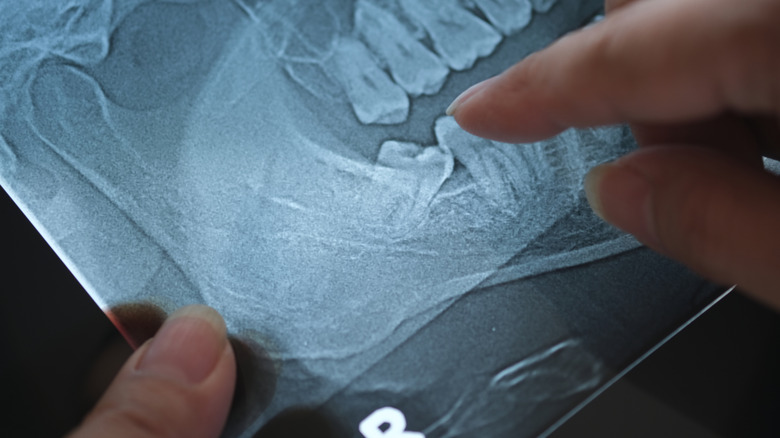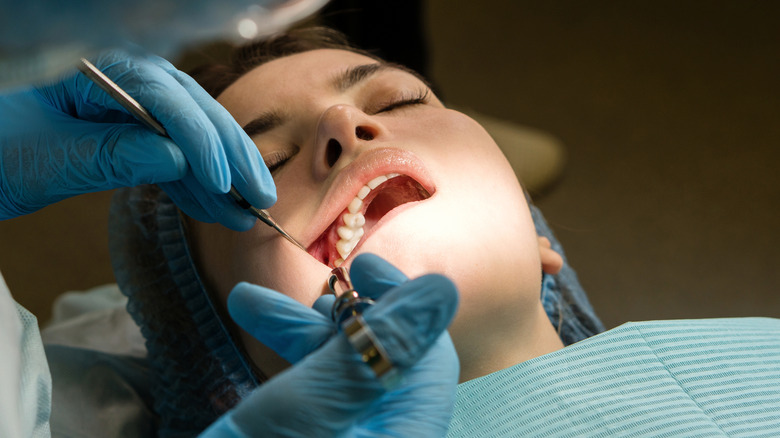The 'Useless' Organ That Can Actually Cause More Harm Than Good
Evolution can be a messy process. As species adapt to new environmental pressures, they're often left with organs that were once critical for their survival but no longer serve any purpose. For instance, the ancestors of whales once walked on land. Now adapted to full-time life in the water, whales still possess tiny unattached pelvis bones. Many snake species, as well, have shriveled remnants of leg bones tucked away in their muscle tissues. Such organs are called vestigial, meaning they're residual ancestral features that no longer aid in survival.
In humans, wisdom teeth are still considered vestigial organs. In other words, they're useless. That may come as a surprise, since those of us who never had our wisdom teeth removed still use them to chew. However, that extra chewing surface provided isn't necessary for survival. In fact, wisdom teeth actually cause more harm than good. When they first emerge, wisdom teeth can push into other teeth and gums, causing an often painful condition called impaction. Once settled into place, wisdom teeth can cause overcrowding of the other teeth, increasing the likelihood of tooth decay, chewing problems, and infections.
However, it is interesting to note that in human anatomy, many of the organs once considered vestigial have been reassessed and reclassified. Perhaps the most well-known example is the appendix, which is more useful than most people believe. The appendix's usefulness as a reservoir for beneficial gut bacteria led scientists to reclassify the organ as non-vestigial in the 2000s. The thymus gland is another such example; long believed to be useless in adults, recent research has demonstrated that the thymus serves the endocrine and lymphatic systems well into adulthood. Unfortunately, the same can't be said for wisdom teeth — they're far from benign.
How our modern diet eliminated the need for wisdom teeth
It's rare for wisdom-tooth-related problems to become life-threatening, but it wasn't too long ago that the extra teeth were actually necessary for survival. After all, we evolved to possess wisdom teeth for a reason. That reason was our diet. Before the advent of cooking and agriculture, humans mostly scavenged the wilderness to find food. Much of our ancestors' diets consisted of tough, hard foods such as tubers and nuts. While our incisors and canines were used to tear and cut those foods, the majority of mastication, such as grinding, cracking, and pulverizing, was performed by our molars. Thus, having four extra molars in adulthood was quite useful.
That all changed during the Paleolithic Era of human evolution. The mastery of fire meant that foods could be cooked before they were eaten, which had the added benefit of softening the food and reducing the workload on our teeth. That workload was reduced even further when agriculture took off around 12,000 years ago. As plants were domesticated for cultivation, species that were easy to chew, like cereals, grains, and rice, were preferred. While cooking threatened the usefulness of wisdom teeth, agriculture was the nail in the coffin.
As agriculture spread, genetic changes and lifestyle changes during childhood have resulted in smaller jaws. For instance, a recent study also points to the role of soft sleeping surfaces, such as mattresses and pillows, in allowing our jaws to develop less defined musculoskeletal structures. All combined, the reduced demands on our jaws have led to weaker jaws and smaller mandibles. So significantly reduced in size, our mouths no longer have enough real estate to accommodate wisdom teeth.
How wisdom teeth can cause serious harm
Some people are lucky enough to never grow wisdom teeth. Researchers estimate that about 35% of people grow only one, two, three, or none at all. For those of us who do have them, there's a risk of lifelong pain, inflammation, and in rare cases, life-threatening infections. Most of us have 20 baby teeth when we're young that are eventually replaced by 32 adult teeth. That replacement process occurs during adolescence, but wisdom teeth wait until we're around 17 years of age to finally make an appearance.
Because wisdom teeth typically erupt by the time the jaw has already grown to nearly full size, the other adult teeth have already settled into place. Without enough room to spare, impaction can occur, in which wisdom teeth push into the bottom of other molars. It's a painful experience that can increase the risk of infection. The only cure for impaction problems is wisdom tooth removal surgery.
But even if wisdom teeth do erupt successfully, they can still cause problems. The introduction of new molars so late in the body's development often pushes on the other teeth, causing overcrowding. Overcrowded teeth can be uncomfortable and increase the risk of infections and tooth decay. Until tooth regeneration becomes a reality, such tooth decay will still require fillings. The increased tightness between overcrowded teeth makes flossing difficult, and the subsequent misalignment can also create areas that are hard to reach with a toothbrush. While many people live with their wisdom teeth intact, dentists usually recommend removing them early on before they can cause problems. Wisdom teeth are one vestigial organ that we're better off without.


